
Herbs have been used for thousands of years by all cultures alike and were the first plants to have been cultivated by mankind. The range of plants that we call herbs has, however, changed over the centuries in Europe. At one time, many familiar flowers such as pinks, peonies, roses and irises were termed herbs, as were most of our common vegetables. In the sixteenth century, for example, carrots and onions were known as pot herbs, whereas lettuces and radishes were called salad herbs. Many aromatic plants, such as sweet woodruff (Galium odoratum) and meadowsweet (Filipendula ulmaria), were also grown purely for their household uses. Although a large proportion of herbs are scented and contain aromatic oils, this is not always the case – many herbs are not fragrant and do not contain any essential oils at all.
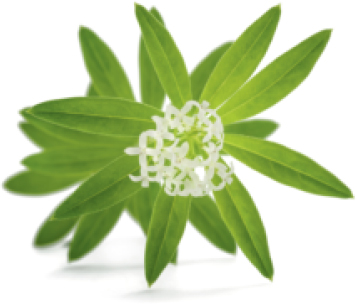
Sweet woodruff (Galium odoratum), above, and meadowsweet (Filipendula ulmaria), below, were traditionally grown to be strewn on floors to create a pleasant aroma.
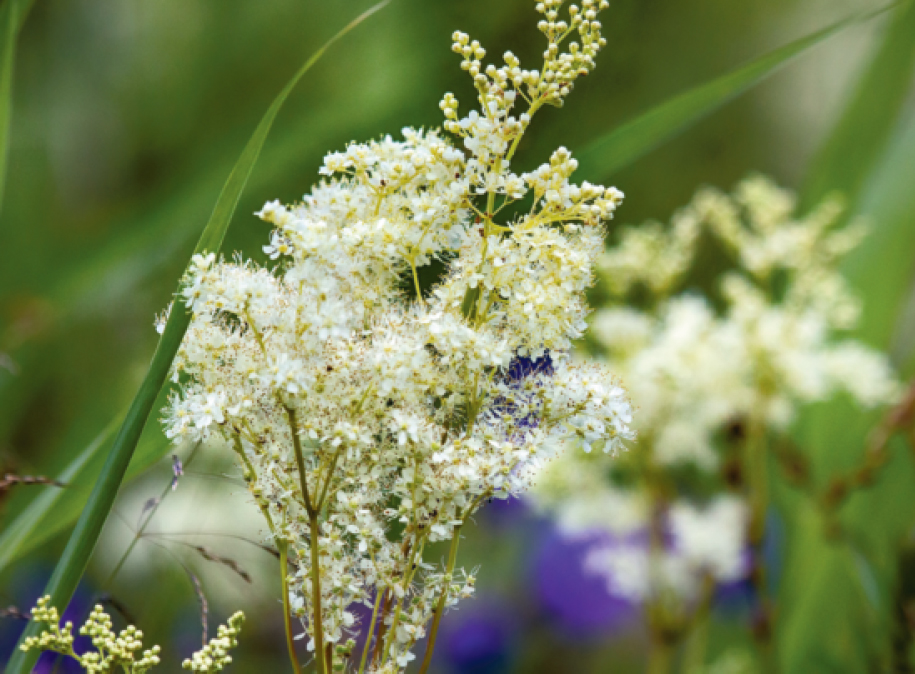
It was in the medieval monastic gardens, however, that the first serious study of herbs took place in Europe and where herbs were grown for their medicinal, culinary and aromatic properties. Herbal treatment was the earliest form of medicine, and consequently the main reason for growing herbs was for their therapeutic benefits. Before the advent of modern drugs, plant medicine was the principal way of combating all kinds of disease, including infections, injury – and witchcraft. The notion of the physic garden began in Europe from the sixth century onwards, when herb gardens were planted next to the infirmary in monasteries. Formal physic gardens were established in Italy in the sixteenth century, first in Pisa in 1543, then in Padua and Florence. Germany, France, Sweden and the Netherlands followed suit, while the first physic garden in England was the Oxford Physic Garden, planted in 1621. After Edinburgh's Physic Garden, the Chelsea Physic Garden was founded in 1673. This is the only physic garden in Britain that has not been turned into a botanic garden and retains its original name.
The physic garden was usually a large plot with raised beds, intersected by paths, where herbs such as lavender, rue, sage, mint and rosemary were each individually confined to a separate bed to make harvesting and identification easier. Both the physic garden and the cloister garth were based on this formal arrangement of paths and beds laid out in regular geometric shapes. The beds were often edged with pegged wooden boards to keep the soil in place, or fences of wattle, and also featured low hedging of compact aromatic shrubs such as box, lavender, rosemary or santolina. Many contemporary herb gardens are still based on these early physic garden designs, using either a grid basis or a cruciform structure – a simple cross with a central circular bed. (See Chapter 6: Planning an Aromatherapy Garden, for other traditional herb garden designs.)
From the Middle Ages onwards, significance was also given to the astrological connection between herbs and the parts of the body ruled by different planets. In his Liber de Vita, Marsilio Ficino (1433–1499) wrote that the sun ruled St John's wort, rosemary and chamomile; Mercury ruled dill, fennel, honeysuckle and lily-of-the-valley, while Venus ruled mint, thyme and violet. The relationship between herbalism and astrology lasted until the eighteenth century when a more pragmatic, scientific approach became prevalent. The Doctrine of Signatures dates back even earlier, originally being developed in the esoteric mystical schools of Alexandria. This connected the shape of a herb with its curative properties and was a doctrine much promoted by Paracelsus in the early sixteenth century. For example, wild pansy, with its heart-shaped leaves, was said to cure disorders of the heart, whereas plants whose leaves are kidney-shaped were thought to be good for the renal system.
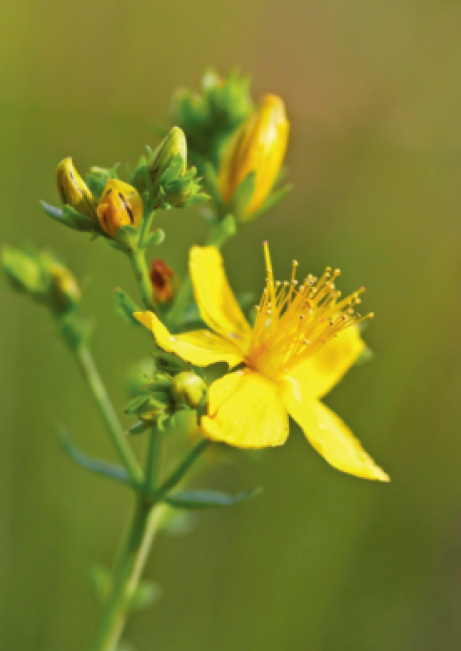
St John's wort (Hypericum perforatum), used for hundreds of years as a natural mood booster.
Today, the main plants to include in a medicinal herb garden are those that can be used to make refreshing and digestive tisanes or herbal teas. These can be made at home from a wide range of plants, including lime flowers, chamomile, mint, sage, lemon balm, verbena and fennel.
In the Middle Ages, scented herbs such as rosemary or lavender were widely used for alleviating damp musty smells and offsetting the effects of poor sanitation, as well as being employed in the sickroom for their antiseptic and disinfectant properties. Herbs such as the cinnamonscented sweet rush (Acorus calamus) or sweet woodruff (Galium odoratum) were used for strewing on floors. Meadowsweet (Filipendula ulmaria) was a favourite herb of Elizabeth I, who had it laid on the floors of her palaces. Others such as hyssop, lavender, sage, chamomile and germander, which release their fragrance when trodden on, were very popular with the gentry and in churches. Bay leaves were also used to disinfect the atmosphere in churches, and chapels strewn with fresh bay leaves can still be found in Italy and other parts of the Mediterranean. Professional perfumers were employed to fumigate rooms in Tudor England, while at the time of James II there was even a ‘Strewer of Herbs in Ordinary to his Majesty’. In more modest cottages, sweet-scented apple wood was burned along with ploughman's spikenard or nard (Inula conyzae) – a species of elecampane.
Aromatic flowers and herbal sprigs were also bound into small posies called ‘tussie mussies’ to ward off sickness or infection and to act as amulets whilst travelling. Herbs such as St John's wort, rosemary, wormwood, mugwort, rue and bay were all thought to have potent protective qualities, and were often planted by doors or hung by windows to ward off bad spirits. Bundles of dried herbs or aromatic powders were also used extensively to scent household items such as bedlinen, clothes or furniture, as well as helping to keep insects and moths at bay. Pot pourri was commonly made using the petals from an enormous range of flowers including roses, marigolds, lavender, iris (orris) and lemon verbena. Perfumes, flower waters and other cosmetic lotions concocted from specially cultivated plants were also popular, the recipes for which would be passed on from generation to generation (see Chapter 5).

Lavender (Lavandula augustifolia), used in the Middle Ages to alleviate bad smells.
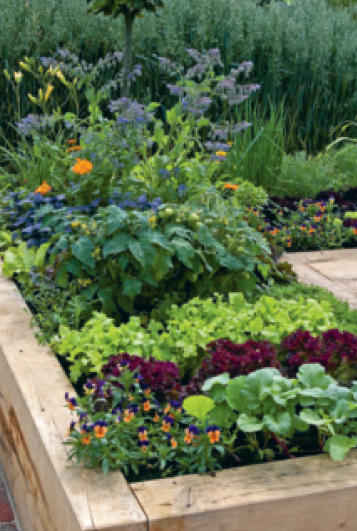
Vegetables, herbs and flowers all grown together.
In 1617, William Lawson wrote The Countrie Housewife's Garden. He not only described medicinal and culinary herbs, but also those which are especially valuable for the still room – where remedies, perfumes, soaps, pot pourri, wines and vinegars were prepared – and for the home. He recommended country women to have both a flower garden and a kitchen garden, and also advised mixing in lavender and roses with the vegetables. Lawson's potager-style arrangement, where vegetables, herbs, ‘still room’ plants and flowers for cutting are combined in an overall scheme, would make a good design for a modern aromatherapy garden.
A romatic culinary herbs have always been grown for their ability to flavour and enhance the preparation of food and drink. The preservative properties of plants were also considered to be invaluable before the advent of modern storage techniques, such as refrigeration, as were their aperitif and digestive properties. Many of the Mediterranean herbs such as bay, marjoram, rosemary and thyme, which all contain large proportions of bactericidal essential oils, were especially highly regarded in this respect, as were spices such as cloves, cardamom, cinnamon and ginger.
The health-giving properties of herbs have also played a part in their culinary application. In the late seventeenth century, for example, salads and herbs were considered most important as scurvy was rife, due to a general lack of fresh fruit and vegetables in the diet. John Evelyn, the diarist, wrote a Discourse on Sallets, as they were known, saying that ‘raw Sallets and Herbs have been found to be the most soveraign Diet’ to get rid of disease. ‘Sweet herbs’ was a term that arose in the seventeenth century to describe sage, marjoram, thyme, hyssop, savory and mint, grown in the kitchen garden, along with vegetables or ‘pot herbs’.
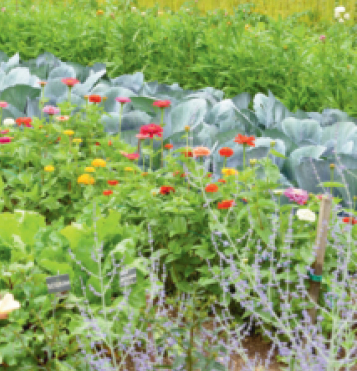
The flower-filled kitchen garden of Château de Miromesnil, France.
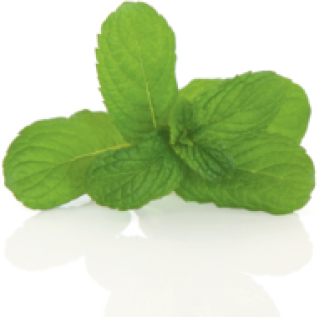
Apple mint (Mentha suaveolens) is rich in essential oils that have antiseptic properties.
The benefits of eating plenty of fresh vegetables, salads and herbs are well recognised today, and herbs are being grown increasingly for their flavouring and therapeutic qualities. Apple mint, for example, is always useful in the kitchen and is highly aromatic. Sweet violet, pot marigold and nasturtiums lend their flowers and leaves to salads or sweet dishes, while lemon balm, lemon verbena and chamomile all make soothing, delicious tisanes. Angelica stalks can be candied and the leaves used in salads. Parsley and chives are invaluable for garnishing, while the subtle flavours of French tarragon and summer savory are excellent in sauces. For more exotic oriental cooking, coriander, caraway and anise are indispensable, while juniper provides small black aromatic berries essential to game dishes. Sweet bay trees planted in tubs can not only be used to mark the corners of borders or as a central feature, but along with such well-known kitchen herbs as thyme and marjoram, their leaves are intrinsic to creating a bouquet garni.
Herbs, of course, can also be grown for their aesthetic appeal, quite apart from any medicinal or culinary usage. Although kitchen herb gardens are traditionally quite formally laid out, in the cottage garden culinary herbs are frequently mixed into informal beds. A modern kitchen herb garden can be based on a formally structured design, as in the early monastery gardens, or can follow a more relaxed cottage-garden style. The famous walled kitchen garden or potager at the seventeenth-century Château de Miromesnil in France, for example, displays a mix of vegetables, herbs and flowers, giving the effect of ‘joyous simplicity and generosity.’ Alternatively, most culinary herbs can be grown in pots, tubs or window boxes which can be placed within easy reach of the kitchen door.
In addition to the herbs listed in Chapter 7, there are a few other species to describe here that are especially valuable for their culinary and household applications.
DILL (Anethum graveolens) This is a hardy annual with attractive heads of golden flowers. Its leaves are similar to fennel and are delicious in salads and soups, as well as with fish. The seeds are very aromatic and can be used in wine vinegars or for pickling cucumbers and gherkins. They can also be steeped in water to soothe stomach upsets and hiccoughs.
BORAGE (Borago officinalis) This was a favoured herb of the ancient world. The Romans brought it to Britain and the Pilgrim Fathers carried it to New England in the early seventeenth century. Its leaves and flowers were steeped in wine to make a tonic – they are used today to flavour Pimms No.1. As its leaves and flowers have a mild cucumber fragrance, they are a pleasant addition to any cool drink in summer. The blue flowers are very decorative in green or fruit salads or floating on a fruit punch. They can also be candied. Borage is a hardy annual, easy to grow and self-seeds freely.
CHERVIL (Anthriscus cerefolium) This herb is popular in French cooking. It enhances the flavour of other herbs and is frequently used in bouquet garnis. Traditionally it is used in egg dishes and as a vegetable garnish. Its foliage is sweet, similar to aniseed. The plant has heads of white flowers and is a delicate annual that prefers light shade. Unlike dill, chervil seeds do not retain their germinating qualities for long and should be sown as soon as possible after ripening.
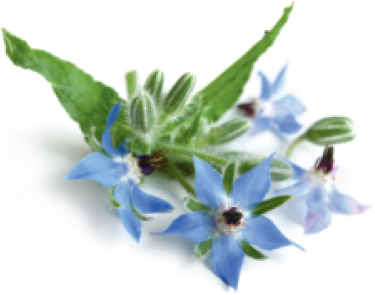
Borage (Borago officinalis)
PARSLEY (Petroselinum crispum) This must be one of the most widely used of all culinary herbs. It is a hardy biennial, usually grown as an annual as its leaves are tough in the second year. Its seeds need moisture and warmth to germinate and the plant likes fertile soil, preferably in full sun or dappled shade. A tip to help encourage the seeds to germinate is to pour a kettle full of boiling water into the earth before planting. There are different varieties: some are flat leaved and some curly. Parsley seeds are used to make essential oils. Medicinally, parsley tea is diuretic and can be used to treat bladder and kidney infections. In the kitchen it is very versatile, for flavouring salads, soups and stews, and egg, fish and meat dishes – in fact virtually all savoury dishes.
SALAD BURNET (Sanguisorba minor) This plant is ideal for salads as the delicate foliage has a mild cucumber-like flavour. It is tasty with vegetables like asparagus or celery, and burnet leaves make an attractive garnish to a fruit salad or fruit cup. It is a decorative plant, too, for in sunshine the dull grey-green leaves take on a pink tinge. They last until the winter when they can also be used to flavour stews and sauces. Salad burnet grows very easily from seed and the summer flowers are green and purple.
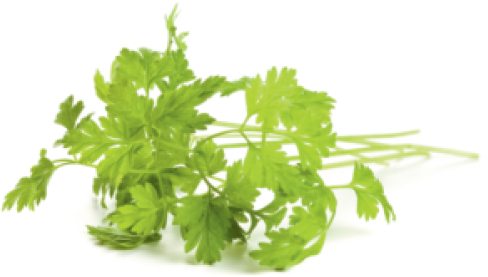
Chervil (Anthriscus cerefolium)
SWEET CICELY (Myrrhis odorata) This is a delicate perennial herb. Its Latin name means literally ‘fragrant perfume’. The crushed unripe green seeds were once used extensively for polishing furniture as they have a fine, nutty anise-like aroma, and the plant is still used to make an essential oil used in perfumery work. Sweet cicely has light green, soft feathery leaves and umbels of white flowers, followed by distinctive long seed pods. It eventually reaches a height of about 1m (3ft) tall but dies down completely over winter. It is an attractive and useful addition to the kitchen garden: the sweet leaves can help to counteract acidity in fruits such as gooseberries or blackcurrants. They can also be used to flavour soups and omelettes.
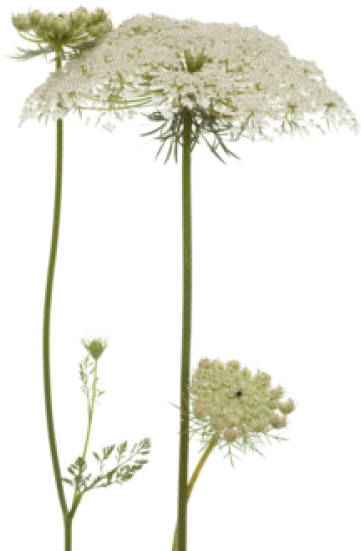
Sweet cicely (Myrrhis odorata)
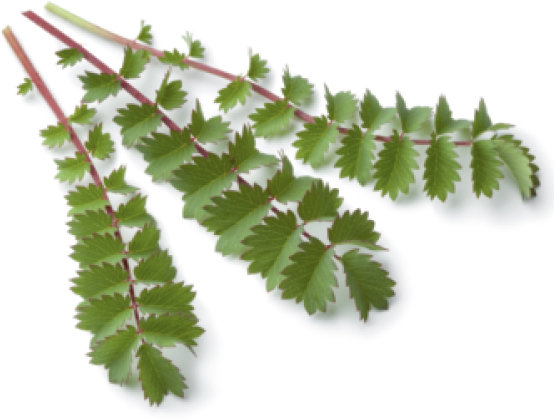
Salad burnet (Sanguisorba minor)
SWEET WOODRUFF (Galium odoratum) A delightful plant for the kitchen garden, sweet woodruff is one of the few herbs that prefer shade. It is a low-growing perennial with small white flowers and, although it is not a culinary herb, it has many household uses. The fresh leaves of sweet woodruff were once hung from the ceiling to perfume and cool the air. It was also placed amongst bed linen to impart a fresh scent and was used in pot pourri. Its scent of new-mown hay comes from its coumarin content and is most pronounced when the plant is dried. It intensifies the longer it is kept. Sweet woodruff has moth-deterrent properties and in dried form can be placed between book pages to remove musty smells.
The following recipes serve four people, unless otherwise specified.
Health-giving herbal teas or tisanes can generally be made using either fresh or dried plant material. Dried plant materials are more concentrated: 1 teaspoon of dried material equals about 3 teaspoons of fresh material. Fresh herbs are often more potent and are likely to have a higher medicinal value, but dried plants are more readily available all year round. Whenever possible, infusions should be made using fresh herbs or flowers as soon as they have been picked. Dosage: use 1 teaspoon of dried herb or 3 teaspoons of fresh herb per cup of water. For very young children or elderly people, use half the dosage. Simply place the herb in a china or enamel tea pot and allow to steep for 10 minutes before drinking. For a more concentrated infusion, pour the water into an enamel pan and bring almost to the boil. Add the herbs and retain on the heat for 10 minutes, maintaining the liquid just beneath boiling point. Drink immediately, adding honey to taste as required.
Almost all culinary herbs can be used to flavour vinegars and oils. This has been done for centuries, particularly in Mediterranean countries. Some herbs are better suited to flavour vinegars, including basil, bay, chervil, chives, dill, fennel, garlic, juniper, lavender, lovage, marjoram, mint, oregano, rosemary, sage, savory, tarragon and thyme. For steeping in oil, the best herbs are basil, bay, chervil, dill, fennel, garlic, juniper, lavender, lovage, marjoram, mint, parsley, rosemary, sage, savory and thyme.
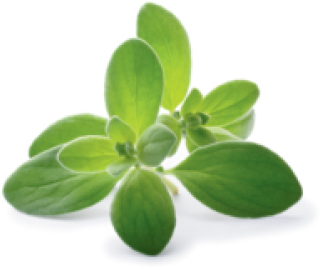
Marjoram (Origanum majorana) can be used to flavour vinegar and oil.
Use good white wine vinegar. Pound a handful of your favourite herb and bruise it well with the pestle and mortar. Add 550ml (1 pint) vinegar to 1 handful of herbs in a widenecked jar, then seal. Leave for a week, then strain. Repeat the process if you require a stronger flavour. After the second week, strain off all the leaves and stems, and bottle the vinegar. Finally, add a few fresh sprigs of the herb for identification and a decorative effect.
Follow the method as above, but substitute the white wine vinegar with good-quality virgin olive oil or sunflower oil.

APPLE AND HERB SOUP
500g (1lb) cooking apples, peeled and cored
Celery tops, finely chopped
½ cup brown sugar
Cinnamon
Cloves
Shredded rind and juice of 1 lemon
Fresh salad burnet leaves
Stew the apples, celery, sugar and spices in 550ml (1 pint) water. When the apples are soft, add lemon juice and rind and cook for a few minutes longer. Leave to cool. Before serving, stir in some salad burnet leaves and decorate the soup with a few extra leaves.

PESTO
4 tablespoons chopped fresh basil
3 garlic cloves, crushed
2 tablespoons ground pine nuts (or walnuts)
3 tablespoons grated Parmesan cheese
5 tablespoons extra-virgin olive oil
Grind the basil, garlic and pine nuts together with a pestle and mortar. Add the Parmesan cheese to form a thick paste. Slowly add the olive oil to the mixture, blending in carefully. This pesto sauce can be heated gently before use with pasta or baked potatoes.
SPINACH WITH DILL
Fresh dill (a generous handful)
1.2kg (2lb) spinach
4 shallots
Butter
Lemon juice
Salt and pepper
Boil or steam the dill, spinach and shallots together. Serve with butter and some lemon juice. Add salt and black pepper to taste.

DILL SAUCE
This is a seventeenth century recipe.
1½ tablespoons butter
1½ tablespoons flour (wholemeal)
1½ cups hot stock
2 tablespoons chopped fresh dill
½ tablespoon lemon juice
Salt and pepper
½ tablespoon brown sugar
1 egg yolk
Melt the butter. Blend in the flour and hot stock gradually, stirring to keep a consistent mix. Add in the dill, lemon juice, salt, pepper and sugar. Cool the sauce slightly, then whisk in the egg yolk. This is delicious served with roast meats, especially beef.

Chop the dill as finely as possible.

Dill (Anethum graveolens)

HOT HERB SLAW
½ cabbage, shredded
2 tablespoons butter
½ cup vegetable stock
Fresh basil, dill and oregano
¾ cup plain yoghurt
Fry the cabbage in the butter for a few minutes, then add the stock with small sprigs of each of the herbs. Simmer for a few more minutes, then add the yoghurt. Cook for a moment longer, then serve.

RAVIGOTE SAUCE
(FOR CHICKEN OR POULTRY)
1 cup meat stock
1 tablespoon (15ml) fresh tarragon
1 tablespoon (15ml) fresh chives
1 tablespoon (15ml) fresh chervil
1 garlic clove, crushed
Remove the fat from the roasting pan but leave the juice. Add stock, the chopped herbs and garlic clove. Bring slowly to the boil. Serve with herbs in the sauce.

CREAMY BASIL SAUCE
2 shallots
1 cup double cream
Handful of fresh basil
Chop the shallots and cook gently with the double cream for a few minutes. Shred the basil finely and divide into two portions. Stir one half into the cream and shallot mixture and use the other to garnish the sauce. This is delicious served with lamb chops or chicken breasts.
HERB BUTTER
1 tablespoon fresh chervil
1 tablespoon fresh chives
1 tablespoon fresh tarragon
1 tablespoon chopped shallots
1 teaspoon lemon juice
500g (1lb) butter
Steam the chervil, chives and tarragon lightly for a few minutes. Drop the shallots into boiling water briefly, then drain and blend with the mixed herbs. Blend the herbs, lemon juice and shallots with the butter. This herb butter is excellent with vegetables, baked potatoes or roast meats.
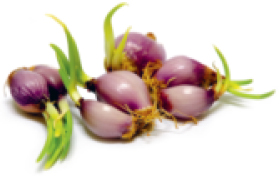
Shallots

LEMON VERBENA JELLY
2 cups fresh lemon verbena leaves
¼ cup cider vinegar
4½ cups sugar
75g (3oz) liquid pectin
Shred the lemon verbena leaves. Pour 2½ cups of boiling water over the leaves, cover and leave to stand for 15 minutes. Strain the mixture and pour into a saucepan. Add the cider vinegar and sugar and bring to the boil. Stir well. Add the pectin and boil thoroughly for about 1 minute, stirring all the while. Pour into sterilised jars and seal.

ANGELICA RATAFIA
This is based on a Victorian recipe.
250g (½lb) angelica stalks
1 litre (2 pints) good brandy
1.2kg (2lb) brown sugar
7g (¼oz) ground mixed cloves and cinnamon
Cut the angelica stalks into small pieces and steep in the brandy. Add 550ml (1 pint) water and the brown sugar, then mix in the spices. Stand for six weeks, then filter and bottle.

Lavender honey

LAVENDER HONEY
550g (1lb) honey
1 cupful lavender leaves
Pour the honey over the lavender leaves and heat gently in a double boiler, simmering for 30 minutes. Strain into sterilised warm jars and seal. Keep for at least a month before using. This honey is excellent for coughs and sore throats, as well as delicious with herb teas.

THYME AND LEMON SAUCE
1 teaspoon coriander seeds
2 tablespoons fresh thyme
2 lemons
1 tablespoon honey
Use a mortar and pestle to crush the coriander seeds and thyme. Squeeze the lemons and add the juice to the thyme and coriander seeds with the honey. Blend thoroughly together. This sauce is particularly delicious with fish dishes.
ROSE PETAL WINE
2 litres (4 pints) scented rose petals
2.5kg (4lb) sugar
Juice of 1 lemon
Wine yeast and nutrient
Mix together the rose petals, sugar and lemon juice. Add 4 litres (1 gallon) boiling water. Steep until the water is lukewarm. Then add the wine yeast and nutrient. Leave the mixture in a warm place for one week to ferment. Stir once a day. Strain into a fermentation jar and fit an airlock. Once a firm deposit has formed, strain into a clean jar. When fermentation has stopped and the wine is clear, strain into clean bottles. Lay by for six months before drinking.
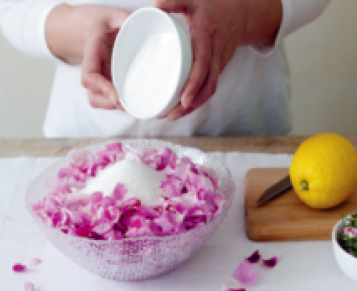
Rose petal wine

MINT PUNCH
1 litre (2 pints) fresh mint leaves
250g (½lb) caster sugar (or more to taste)
2 cups grape juice
Lemon juice
1 litre (2 pints) ginger ale
Mint leaves and glacé cherries to garnish
Grind the washed mint leaves in a bowl until soft. Dissolve the caster sugar in boiling water, add to the mint leaves and steep for 10 minutes. Strain off the mint leaves and add grape juice and lemon juice to taste. Check sweetness and if necessary add more caster sugar. Add the ginger ale. Refrigerate until cold. In summer, serve with ice together with fresh mint leaves and glacé cherries as a garnish.
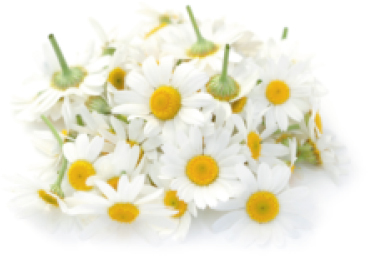
Chamomile (Matricaria recutita)

SPICY FRUIT TEA
3 tablespoons whole cloves
1 cinnamon stick
1 cup dried orange peel
1 cup dried orange mint
1 cup chamomile flowers
2 cups dried lemon verbena leaves
Grind the cloves and cinnamon to a fine mixture. Add to the orange peel and mint, then combine the mixture with the chamomile flowers and lemon verbena leaves. Store in an airtight tin. Add boiling water to the tea in the usual fashion and steep for 10 minutes before drinking.

BORAGE SUMMER WINE
Fresh borage leaves and flowers
White wine
Sugar to taste
Lemon slices
Steep the borage leaves in a small quantity of boiling water. Cool. Strain off the leaves. Add the cucumberflavoured water to white wine, sweeten with sugar to taste and add a couple of slices of lemon. Serve with blue borage flowers as decoration.